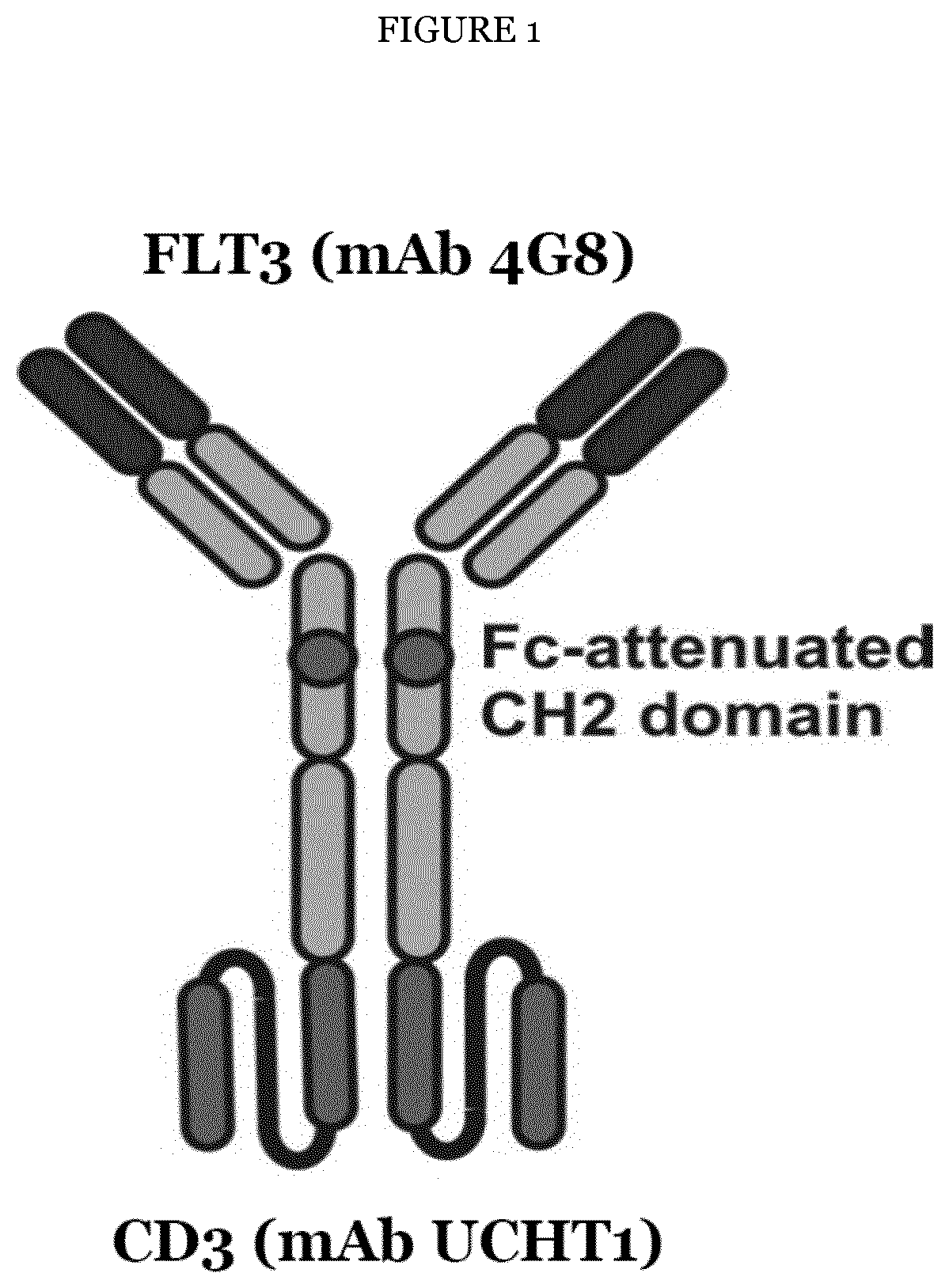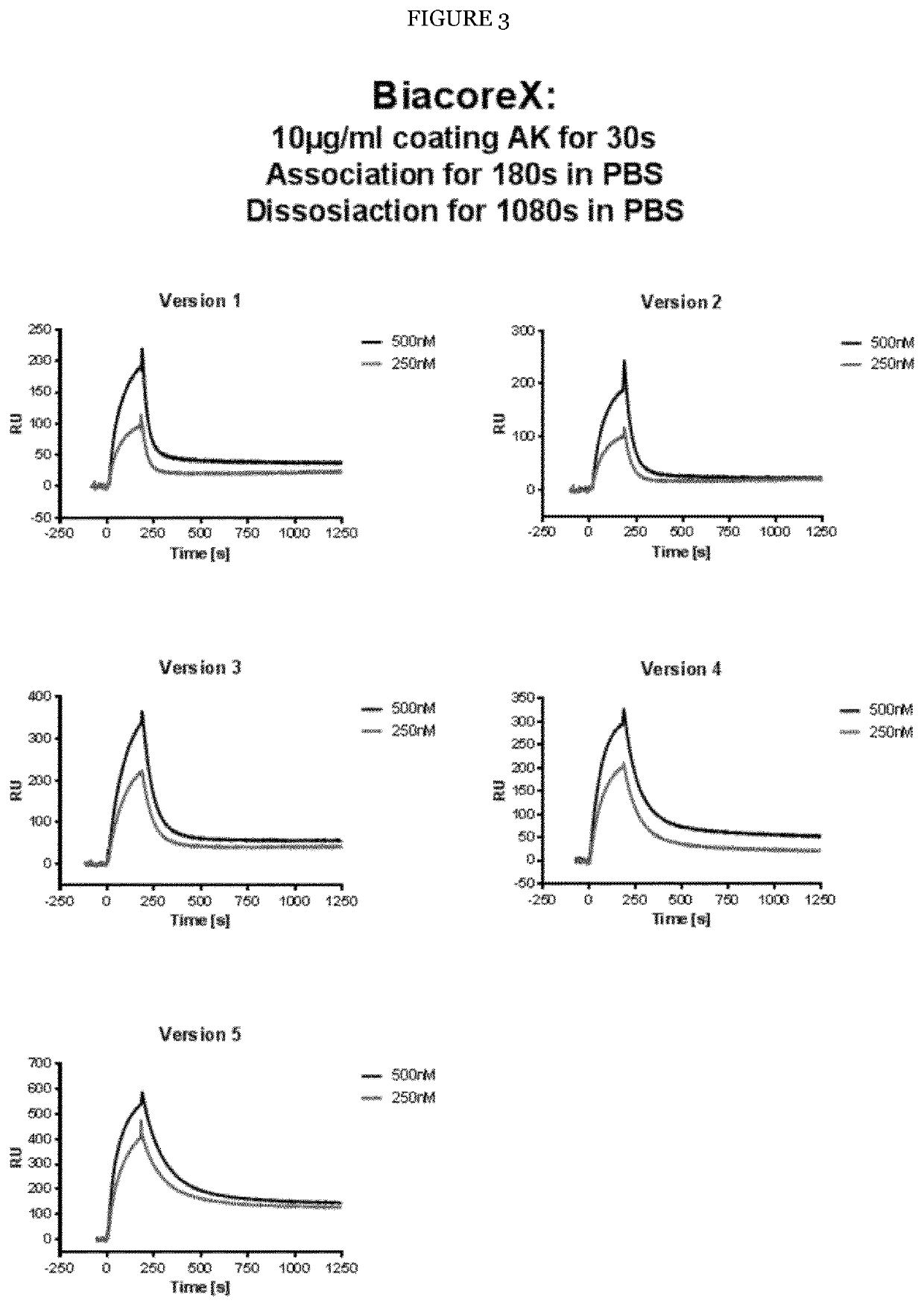Improved Anti-FLT3 Antigen Binding Proteins
a technology of flt3 and binding proteins, which is applied in the field of improved anti-flt3 antigen binding proteins, can solve the problems of preventing the optimal therapeutic activity of bispecific antibodies stimulating the tcr/cd3 complex, affecting the quality and quantity of bispecific antibodies, and affecting the effect of drug safety and safety, so as to enhance the cell-mediated immune response and enhance the immune respons
- Summary
- Abstract
- Description
- Claims
- Application Information
AI Technical Summary
Benefits of technology
Problems solved by technology
Method used
Image
Examples
example 1
n of Recombinant Bispecific FLT3×CD3 ABPs (CC-2)
[0213]The 4G8 anti-FLT3 antibody was used for construction of recombinant bispecific ABPs in the IgGsc format (FIG. 1), that is, the variable domain of the mouse FLT3 antibody 4G8 was fused to human constant regions and variable regions of the CD3 antibody UCHT1 in the following order. VL-CL for the light chain and VH-CH1-CH2mod-CH3-scFv(UCHT1) for the heavy chain (see FIG. 1). In these ABPs, the FLT3 binding site is present as Fab2 fragment while the CD3 binding site is present as scFv fragment (cf. again FIG. 1). To abrogate FcR-binding, the following modifications were introduced into the hinge region and the CH2 domain (EU-index): E233P; L234V; L235A; AG236; D265G; A327Q; A330S (see in this respect also International patent application WO 2013 / 092001). The constructs were cloned in an expression vector derived from pcDNA3.1 (InVitrogen, Thermo Fisher) as also described in International patent application WO 2013 / 092001 and transien...
example 2
n of Humanized 4G8 Antibodies
[0214]The 4G8 anti-FLT3 antibody was humanized by grafting the CDR regions of the light chain of the antibody 4G8 (that means the CDR loops of SEQ ID NO: 5 to SEQ ID NO: 7) into (the variable domain) of the human κ light sequence IGKV3-15*01 that is deposited in the IMGT / LIGM-database under accession number M23090, see also Ichiyoshi Y., Zhou M., Casali P. A human anti-insulin IgG autoantibody apparently arises through clonal selection from an insulin-specific ‘germ-line’ natural antibody template. Analysis by V gene segment reassortment and site-directed mutagenesis' J. Immunol. 154(1):226-238 (1995). Further the CDR regions of the heavy chain of the antibody 4G8 (that means the CDR loops of SEQ ID NO: 01 to SEQ ID NO: 03) were included into the (variable domains) of the heavy chain sequence IGHV1-46*03 which is deposited in the IMGT / LIGM-database under accession number L06612 (See also Watson C. T., et al. Complete haplotype sequence of the human immun...
example 3
n of Inventive Variants of Bispecific FLT3×CD3 ABPs (CC-2)
[0215]Multiple variants (V1 to V5) of the FLT3 binding domain of humanized 4G8 were generated. Furthermore, multiple published variants of the CD3 binding domain scFv derived from the humanized CD3 antibody UCHT1 (V7 to V9) were used in various combinations with the inventive FLT3 binding domain variants. The following preferred mutated variants having specific technical effects that are desirous for the use of such humanized 4G8 variants were identified (CDRs are underlined, and mutations are indicated vis-à-vis the corresponding heavy and light chains present in the humanized 4G8 FLT3 antigen binding domain detonated as Variant 0 or V0):
[0216]Humanized 4G8 FLT3 variable region Variant 1 (V1)
Heavy chain variable region:
Mutations: K16G, V18L, K19R, V20L, K22A, K57T, N60A, M69I, T70S, T75K, S76N, V78L, M80L, E81Q, S87A, T108L
[0217]
QVQLVQSGAEVKKPGGSLRLSCAASGYTFTSYWMHWVRQAPGQGLEWIGEIDPSDSYTDYAQKFKDRVTISRDTSKNTLYLQLSSLRAEDTAVYYCA...
PUM
| Property | Measurement | Unit |
|---|---|---|
| concentrations | aaaaa | aaaaa |
| fluorescent activated cell sorting | aaaaa | aaaaa |
| surface plasmon resonance | aaaaa | aaaaa |
Abstract
Description
Claims
Application Information
 Login to View More
Login to View More - R&D
- Intellectual Property
- Life Sciences
- Materials
- Tech Scout
- Unparalleled Data Quality
- Higher Quality Content
- 60% Fewer Hallucinations
Browse by: Latest US Patents, China's latest patents, Technical Efficacy Thesaurus, Application Domain, Technology Topic, Popular Technical Reports.
© 2025 PatSnap. All rights reserved.Legal|Privacy policy|Modern Slavery Act Transparency Statement|Sitemap|About US| Contact US: help@patsnap.com



